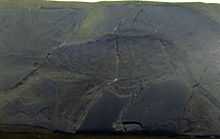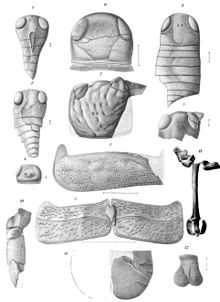Erettopterus
| Erettopterus Temporal range: Silurian–Devonian | |
|---|---|
 | |
| Erettopterus bilobus at the Museum für Naturkunde, Berlin | |
| Scientific classification | |
| Kingdom: | Animalia |
| Phylum: | Arthropoda |
| Class: | Merostomata |
| Order: | †Eurypterida |
| Superfamily: | †Pterygotioidea |
| Family: | †Pterygotidae |
| Genus: | †Erettopterus Salter in Huxley & Salter, 1859 |
Erettopterus is a genus of prehistoric eurypterid.[1] It was related to another large eurypterid, Pterygotus.
Description

Fossils 1-11
Pterygotidae, which lived from the Ordovician to Devonian periods, were characterized by small to large exoskeletons with semilunar scales. The telson, (tail) was expanded, or flatter than it was tall. Pterygotidae also had chelicerae (claws in front of the mouth) that were large and long, with strong, well developed teeth on the claws. Their walking legs were small and slender, without spines.[2]
Erettopterus is distinguishable from other Pterygotidae by its telson, which is bilobed. The distal margins of the chelicerae are angular. The prosoma (head) is semielliptical, with compound eyes located at the edge.[3]
Species
- Erettopterus Salter in Huxley & Salter, 1859
- Erettopterus bilobus (Salter, 1856) — Silurian, Scotland
- = Eurypterus perornatus Salter, 1856 — Silurian, Scotland
- = Pterygotus bilobus var. acidens Woodward, 1878 — Silurian, Scotland
- = Pterygotus bilobus var. crassus Woodward, 1878 — Silurian, Scotland
- = Pterygotus bilobus var. inornatus Woodward, 1878 — Silurian, Scotland
- = Pterygotus bilobus var. perornatus Woodward, 1878 — Silurian, Scotland
- = Pterygotus perornatus var. plicatissimus Salter in Huxley & Salter, 1859 — Silurian, Scotland
- Erettopterus brodiei Kjellesvig-Waering, 1961 — Silurian, England
- Erettopterus canadensis (Dawson, 1879) — Silurian, Canada
- Erettopterus exophthalmus Kjellesvig-Waering & Leutze, 1966 — Silurian, USA
- Erettopterus gigas Salter in Huxley & Salter, 1859 — Silurian, England
- Erettopterus globiceps Clarke & Ruedemann, 1912 — Silurian, USA
- Erettopterus grandis Pohlman, 1881 — Silurian, USA
- Erettopterus holmi (Størmer, 1934) — Silurian, Norway
- Erettopterus laticauda Schmidt, 1883 — Silurian, Estonia
- Erettopterus marstoni Kjellesvig-Waering, 1961 — Silurian, England
- Erettopterus megalodon Kjellesvig-Waering, 1961 — Silurian, England
- Erettopterus osiliensis Schmidt, 1883 — Siluria, Estonia,
- Erettopterus saetiger Kjellesvig-Waering, 1964 — Silurian, USA
- Erettopterus serratus Kjellesvig-Waering, 1961 — Devonian, USA
- Erettopterus spatulatus Kjellesvig-Waering, 1961 — Silurian, England
- ?Erettopterus vogti Størmer, 1934a — Devonian, Norway
- Erettopterus waylandsmithi Kjellesvig-Waering & Caster, 1955 — Silurian, USA
- Erettopterus bilobus (Salter, 1856) — Silurian, Scotland
See also
- List of eurypterids
References
- ↑ "The Paleobiology Database". Retrieved 2008-12-02.
- ↑ Størmer, L 1955. Merostomata. Treatise on Invertebrate Paleontology, Part P Arthropoda 2, Chelicerata, P: 30.
- ↑ Størmer, L 1955. Merostomata. Treatise on Invertebrate Paleontology, Part P Arthropoda 2, Chelicerata, P: 31.